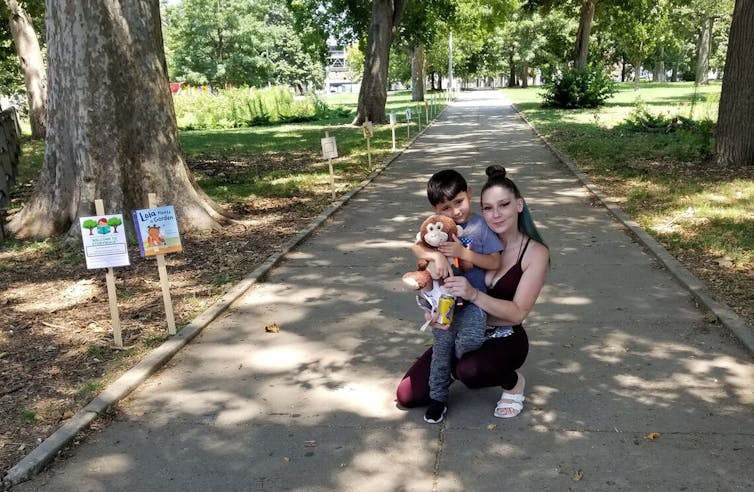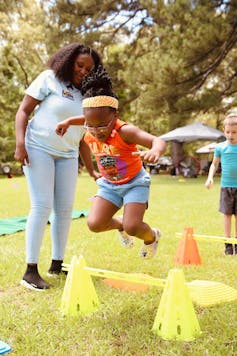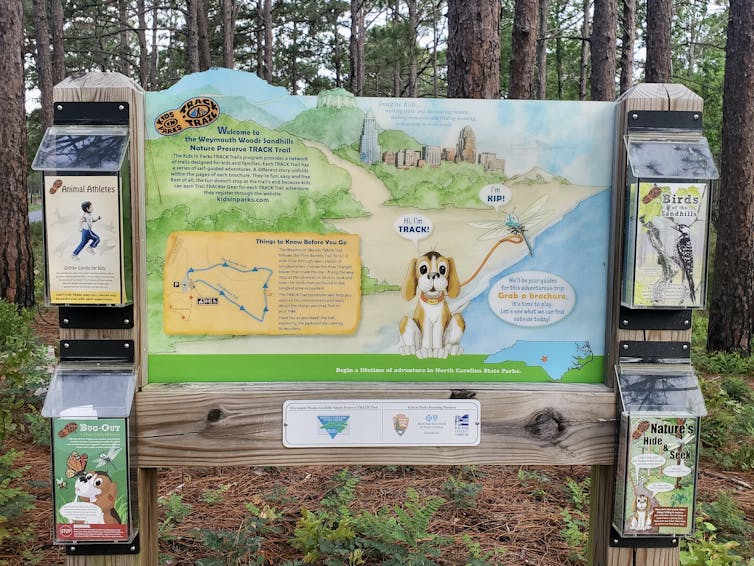4 low-cost ways to create safe public spaces where all kids can play
- Written by Renee Umstattd Meyer, Professor of Public Health, Baylor University
Outdoor play is critical for child development[1] – it decreases stress, increases communication and social skills, attention and physical activity, and enhances physical development.
During COVID-19, opportunities for children to socially connect, reduce stress and play outside have been desperately needed[2] but also greatly limited. As understanding of COVID-19 expanded, outdoor spaces emerged as an ideal place[3] for activities to occur with limited risk.
Opportunities for children to play are especially important during the summer months[4], when young people tend to be less active, watch more screens and enjoy physical activity less. Studies show that American Indian, Asian American, Black and Latino[5] youth in particular reduce the amount of time they spend on physical activity in summer compared to the school year.
As professors of public health[6] and community health[7], we examine how community collaborations can create opportunities for more play – and more equitable play – while also building neighborhood cohesion. Below we highlight four such opportunities.
Shared-use agreements
Shared-use agreements, also called joint-use and community-use agreements, are when public, private or nonprofit organizations allow community access to their facilities or physical spaces. For example, a school may let local residents use their playground, soccer field or running track when school is not in session.
Even in states like California, where state laws encourage civic use of public school facilities, many schools lock their grounds[8] and are inaccessible to community residents. A report[9] from the Trust for Public Land, a conservation nonprofit that advocates for public access to outdoor spaces, estimates that only 10%[10] of U.S. public schools give the general public formal access to schoolyard sites.
Shared-use agreements can provide a safe place for physical activity in any type of community – rural, suburban or urban. They are especially useful in low-income communities with fewer park spaces, less-safe parks and parks of lower quality[11]. Partners may include schools, faith institutions, businesses, libraries and hospitals that could have an outdoor playground, running track or other open spaces for physical activity.
ChangeLab Solutions[12], a health equity nonprofit, provides toolkits, examples and model agreements for people interested in providing safe places for play and physical activity in their community.
 ‘Lola Plants a Garden’ is featured at a StoryWalk in Harrowgate Park in North Philadelphia.
Friends of Harrowgate Park, CC BY-NC-ND[13][14]
‘Lola Plants a Garden’ is featured at a StoryWalk in Harrowgate Park in North Philadelphia.
Friends of Harrowgate Park, CC BY-NC-ND[13][14]
StoryWalks
StoryWalks[15] are typically a collaboration between a local library and local park system in which a children’s book is reproduced on semi-permanent displays along a walking trail. Kids – and importantly their friends, family and caregivers – are invited to read the story along a journey of the park path.
Stories can be embellished with suggested activities such as “hop like Peter Rabbit” or “crawl like the Very Hungry Caterpillar.” Libraries and parks and recreation departments work together to identify culturally relevant and active books to install, and which parks to target. The partnership can bring reading and activities to underutilized and under-programmed parks.
Let’s Move in Libraries[16] and the American Library Association provide examples and suggestions to get started, including ways to creatively connect[17] families, books and nature[18].
Play Streets
Play Streets[19] typically close down a residential street, but can be located in any public space – like a parking lot, field, playground or park – where kids can safely play outside during a specified time, typically in the summer.
 Children enjoy a Play Street in Bastrop, Louisiana in June 2021.
D. Jones Visuals, CC BY-NC-ND[20]
Children enjoy a Play Street in Bastrop, Louisiana in June 2021.
D. Jones Visuals, CC BY-NC-ND[20]
Individuals or community groups can host them and partner with other organizations – such as the local health department, county extension office[21], library, faith institution, school or fire or police station. These partners can help supply additional volunteers and equipment like bouncy houses, hula hoops, jump ropes, sports equipment and potato sacks for races.
Play Streets are affordable to implement and require few resources. Children play in the various activity areas, sometimes with adult facilitation, but mostly through child-directed free play.
The Rural Play Streets Guide[22], which one of us co-developed with Keshia Pollack Porter[23], a professor at Johns Hopkins Bloomberg School of Public Health, has a step-by-step guide to help anyone – whether rural, suburban or urban – plan Play Streets in their community.
 A mile-long TRACK Trail loop in North Carolina offers brochures with different activities to complete.
J. Aaron Hipp, CC BY[24]
A mile-long TRACK Trail loop in North Carolina offers brochures with different activities to complete.
J. Aaron Hipp, CC BY[24]
TRACK Trails
TRACK Trails[25] are lightly guided adventures using signs and pamphlets posted around parks, lakes, trails or one’s own backyard. For instance, a local half-mile trail might encourage kids to complete multiple animal exercises[26] during the walk, such as sprinting like a rabbit for 20 seconds or doing a series of long jumps like a grasshopper.
Kids and families can visit the TRACK Trails website to find an adventure[27] or print seasonal activities to complete in their neighborhood. They can also log activities and be rewarded with prizes. Lower-resourced communities can get financial assistance to install trails or print brochures. Additional information can be found here[28].
[Get our best science, health and technology stories. Sign up for The Conversation’s science newsletter[29].]
References
- ^ critical for child development (doi.org)
- ^ desperately needed (www.doi.org)
- ^ ideal place (www.cdc.gov)
- ^ especially important during the summer months (doi.org)
- ^ American Indian, Asian American, Black and Latino (paresearchcenter.org)
- ^ public health (scholar.google.com)
- ^ community health (scholar.google.com)
- ^ lock their grounds (dhhr.wv.gov)
- ^ A report (www.tpl.org)
- ^ estimates that only 10% (www.tpl.org)
- ^ fewer park spaces, less-safe parks and parks of lower quality (doi.org)
- ^ ChangeLab Solutions (www.changelabsolutions.org)
- ^ Friends of Harrowgate Park (loveyourpark.org)
- ^ CC BY-NC-ND (creativecommons.org)
- ^ StoryWalks (www.kellogghubbard.org)
- ^ Let’s Move in Libraries (letsmovelibraries.org)
- ^ including ways to creatively connect (programminglibrarian.org)
- ^ families, books and nature (www.childrenandnature.org)
- ^ Play Streets (doi.org)
- ^ CC BY-NC-ND (creativecommons.org)
- ^ county extension office (nifa.usda.gov)
- ^ Rural Play Streets Guide (www.baylor.edu)
- ^ Keshia Pollack Porter (www.jhsph.edu)
- ^ CC BY (creativecommons.org)
- ^ TRACK Trails (www.kidsinparks.com)
- ^ animal exercises (www.kidsinparks.com)
- ^ find an adventure (www.kidsinparks.com)
- ^ can be found here (www.kidsinparks.com)
- ^ Sign up for The Conversation’s science newsletter (theconversation.com)

















